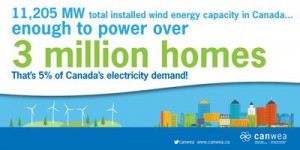Wind power is gaining speed in Canada. At the end of 2015, the country was the seventh largest in the world for total installed energy capacity with 11,205 MW and sixth in the world for the amount of capacity added in 2015 according to the Canadian Wind Energy Association (CanWEA). In total for 2015, Canada added 1,506 MW of new wind capacity through the commissioning of 36 projects, 23 of which involved Aboriginal Peoples, municipal or local ownership. Wind energy supplied nearly 5 percent of the country’s electricity demand.
“Not only has the wind energy industry continued its five year trend as the largest source of new electricity generation in Canada,” said CanWEA President Robert Hornung, “the industry in Canada has demonstrated a five year annual average growth rate of 23 per cent per year (an average of 1,438 MW per year).”
 Ontario lead the way again in 2015 in market size and growth, adding 871 MW of installed capacity in 2015 for a new total of 4,361 MW. Between contracts signed and planned new purchases through the province’s new Large Renewable Procurement process, there remains more than 2,000 MW of wind slated to be built in Ontario in the next few years.
Ontario lead the way again in 2015 in market size and growth, adding 871 MW of installed capacity in 2015 for a new total of 4,361 MW. Between contracts signed and planned new purchases through the province’s new Large Renewable Procurement process, there remains more than 2,000 MW of wind slated to be built in Ontario in the next few years.
Quebec, Canada’s second largest wind energy market, was also the second largest contributor of new installed capacity in 2015, adding 397 MW for a total of 3,262 MW. This included the largest multi-phase project commissioned in Canada to date – the 350 MW wind farm in Riviere du Moulin. The first phase with 150 MW was commissioned in 2014 and the remaining 200 MW was commissioned in 2015. The province has another 700 MW due to come online in the next two years.
Six wind turbine manufacturers (OEMs), all CanWEA members, supplied the technology for the new wind capacity commissioned in 2015 in Canada. Siemens Canada Limited led installations with close to 50 percent, followed by Senvion Canada Inc., GE Renewable Energy, ENERCON, Acciona Wind Energy Canada and Vestas Canada.
“Canada’s new wind energy projects in 2015 represent over $3 billion in investment,” said Hornung. “Wind energy is now providing economic growth and diversification to well over 100 rural communities across Canada through land lease income, tax payments and community benefits agreements.”
U.S. investment bank Lazard reported that over the past six years, utility scale wind plummeted 60 percent. That positions wind power as a cost-competitive with nearly every other energy source and costs are expected to continue to drop.
Hornung added, “As we look ahead in Canada, we expect at least another 1,000 MW to be installed by the end of 2016. “The recent policy decisions in Alberta and Saskatchewan provide clear evidence that wind energy’s growth prospects will remain strong beyond then as well.”

